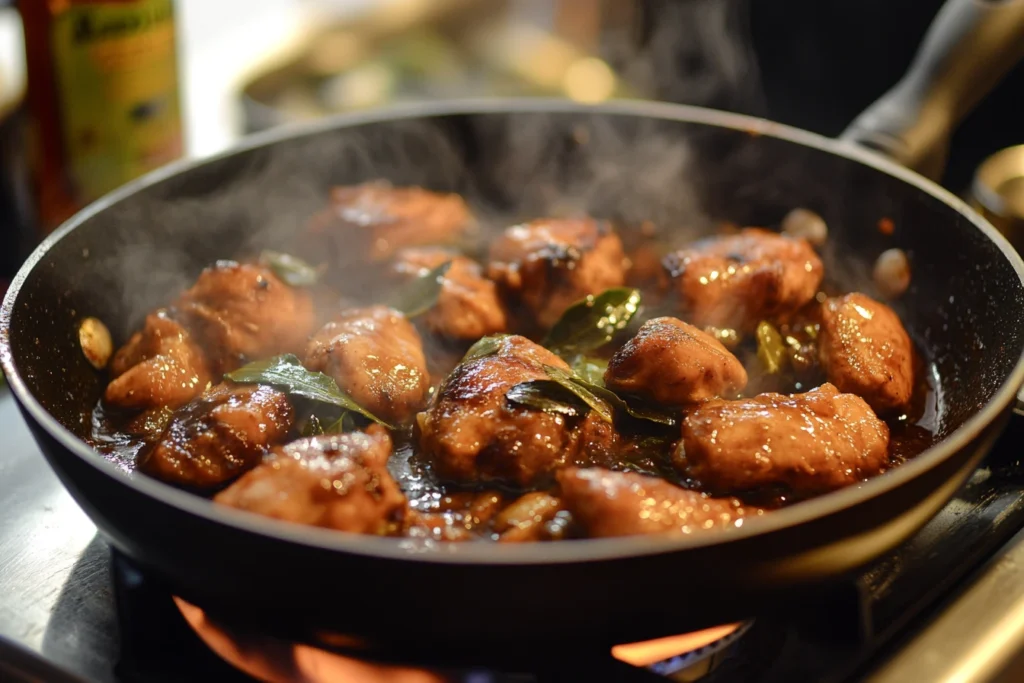Introduction
What Kind of Vinegar is Best for Chicken Adobo? Chicken adobo is a cornerstone of Filipino cuisine, beloved for its bold flavors and cultural significance. This dish, often praised for its tangy and savory profile, relies heavily on one key ingredient: vinegar. Choosing the right vinegar can transform a good adobo into an unforgettable culinary masterpiece. In this article, we’ll explore the best vinegars for chicken adobo, compare their flavors, and provide tips to elevate your cooking. Let’s dive into the world of tangy goodness, starting with understanding the essence of chicken adobo.
Understanding Chicken Adobo
What Is Chicken Adobo?
Chicken adobo is a traditional Filipino dish that has stood the test of time. Rooted in the country’s rich culinary history, adobo is not only a flavorful meal but also a testament to the resourcefulness of Filipino cooks. The dish typically features chicken marinated and cooked in soy sauce, vinegar, garlic, bay leaves, and black peppercorns. This combination results in tender meat bathed in a savory and tangy sauce.
But what makes chicken adobo truly special is its adaptability. It’s not just about the ingredients; it’s how you balance them. From home kitchens to festive celebrations, adobo is a versatile dish that resonates with every Filipino household. The secret to its heartwarming flavor often lies in the type of vinegar used, which shapes its tangy backbone.
Why Is Vinegar a Key Ingredient in Adobo?
The inclusion of vinegar in chicken adobo is more than just tradition; it’s a culinary necessity. Vinegar plays a crucial role in breaking down proteins, tenderizing the meat, and enhancing the dish’s overall flavor. Its acidity creates a harmonious balance, cutting through the richness of soy sauce while amplifying the garlic and pepper notes.
In addition to its flavor-enhancing properties, vinegar acts as a natural preservative. This was particularly important in the pre-refrigeration era, allowing adobo to last longer without spoiling. Today, vinegar continues to be a defining element, offering depth and complexity to the dish. However, not all vinegars are created equal, and the choice of vinegar can significantly influence the outcome of your adobo.
Exploring Vinegar Options
Types of Vinegar Commonly Used for Chicken Adobo
The type of vinegar you use in chicken adobo can make or break the dish. Each vinegar contributes its unique flavor profile, making the choice both exciting and crucial. Let’s explore the most popular options and their impact on this iconic recipe.
Cane Vinegar
Cane vinegar is the traditional choice for Filipino chicken adobo. Made from fermented sugarcane, it delivers a mild yet tangy flavor with a hint of sweetness. This vinegar balances the savory soy sauce beautifully without overpowering the dish. Its subtle sweetness enhances the chicken’s natural flavors, making it a go-to for many Filipino cooks. If authenticity is your goal, cane vinegar is the way to go.
Coconut Vinegar
Coconut vinegar, derived from the sap of coconut trees, is another popular option in the Philippines. It has a unique, earthy flavor that pairs well with the bold spices in adobo. Slightly less acidic than other vinegars, coconut vinegar adds a gentle tang while maintaining the dish’s robust flavor. Its regional significance makes it a favorite for those seeking a traditional twist with a tropical touch.
Apple Cider Vinegar
Apple cider vinegar has gained popularity outside the Philippines for its fruity and tart notes. While not traditional, it offers a modern adaptation for chicken adobo. Its bold flavor adds depth, making it a great option for cooks looking to experiment. However, apple cider vinegar’s assertiveness means it should be used sparingly to avoid overpowering the dish.
White Distilled Vinegar
White distilled vinegar is a versatile option that’s often readily available. Its sharp, clean acidity gives chicken adobo a pronounced tang, making it a favorite for those who enjoy a bold and zesty flavor. While it lacks the nuanced sweetness of cane or coconut vinegar, it excels in creating a bright and vibrant dish.
Rice Vinegar
Rice vinegar, commonly used in Asian cuisine, adds a subtle sweetness to chicken adobo. Its lower acidity makes it a gentle choice, perfect for those who prefer a milder tang. While it’s not a traditional option, rice vinegar complements soy sauce and spices beautifully, resulting in a delicate yet flavorful adobo.
How Different Vinegars Impact Chicken Adobo
Each type of vinegar brings its own personality to chicken adobo. Traditionalists may lean toward cane or coconut vinegar for an authentic taste, while adventurous cooks might experiment with apple cider or rice vinegar to create something unique. The key is to choose a vinegar that matches your flavor preferences and enhances the dish’s overall harmony.

Comparing Vinegars for Adobo
Which Vinegar Offers the Best Flavor for Adobo?
The perfect vinegar for chicken adobo depends on your desired flavor profile. Each type of vinegar has distinct characteristics that affect the dish’s taste, texture, and aroma. Let’s delve into a detailed comparison of the most popular options to help you decide.
Flavor Analysis of Popular Choices
- Cane Vinegar: With its mild acidity and touch of sweetness, cane vinegar provides a balanced flavor that enhances the dish without overwhelming it. It’s perfect for those seeking a traditional, homey taste.
- Coconut Vinegar: Earthy and slightly tangy, this vinegar offers a unique depth that pairs well with the richness of soy sauce and spices. It’s ideal for an authentic Filipino feel.
- Apple Cider Vinegar: Fruity and bold, apple cider vinegar introduces a contemporary twist. Its tartness is perfect for those who enjoy experimenting with fusion flavors.
- White Distilled Vinegar: Sharp and acidic, this option delivers a pronounced tang, making it a favorite for cooks who prefer a zesty adobo.
- Rice Vinegar: Gentle and subtly sweet, rice vinegar creates a delicate dish, ideal for those who prefer less acidic meals.
How Vinegar Affects Texture and Aroma
Vinegar does more than just enhance taste—it also impacts the texture and aroma of chicken adobo. The acidity in vinegar helps tenderize the chicken, resulting in meat that’s juicy and succulent. Furthermore, vinegar’s aromatic qualities blend beautifully with garlic and soy sauce, creating a mouthwatering scent that fills the kitchen.
Balancing Tradition and Modern Preferences
For a classic chicken adobo, cane or coconut vinegar are unbeatable choices. However, modern cooking allows for creativity, and blending vinegars can yield surprising results. For example, mixing cane and apple cider vinegar adds both authenticity and a tart kick, making the dish uniquely yours.
Selecting the Perfect Vinegar
How to Choose the Best Vinegar for Your Taste
Choosing the right vinegar for chicken adobo comes down to personal preference. While traditionalists might opt for cane or coconut vinegar, modern cooks have the freedom to experiment. Here are some key factors to consider when selecting your vinegar:
- Flavor Profile: Think about whether you prefer a bold tang, a gentle sweetness, or a balance of both. Cane vinegar is mildly sweet, while white distilled vinegar has a sharper edge.
- Acidity Level: If you enjoy a strong kick, go for white vinegar. For a subtler touch, rice vinegar or coconut vinegar might be more appealing.
- Availability: In some regions, cane or coconut vinegar may not be easy to find. Substituting with apple cider or rice vinegar is perfectly acceptable and can still result in a delicious dish.
- Cultural Authenticity: If your goal is to replicate a traditional Filipino adobo, stick with cane or coconut vinegar for a truly authentic taste.
Recommendations for Different Types of Chicken Adobo
Not all chicken adobo dishes are the same, and the type of vinegar you use can complement various styles:
- Classic Adobo: Cane vinegar offers the best balance of sweetness and tang for a traditional flavor.
- Sweet Adobo: Rice vinegar enhances the sweetness in dishes that incorporate sugar or honey.
- Spicy Adobo: White distilled vinegar cuts through the heat, creating a vibrant, spicy profile.
- Fusion Adobo: Apple cider vinegar adds a fruity undertone that pairs well with non-traditional spices or ingredients.
By considering these factors, you can tailor your vinegar choice to match your desired outcome, ensuring that your chicken adobo is perfectly suited to your taste buds.
Cooking with Vinegar
Techniques for Using Vinegar in Chicken Adobo
Vinegar is not just an ingredient; it’s a technique in itself when it comes to chicken adobo. Knowing how to use it effectively can elevate your dish to restaurant-quality levels. Here are some essential tips and techniques:
- Marinating the Chicken: Allowing the chicken to sit in a mixture of vinegar, soy sauce, and garlic for at least 30 minutes infuses the meat with flavor. This step also tenderizes the chicken, ensuring a juicy texture.
- Cooking Sequence: Vinegar should be added early in the cooking process but not stirred immediately. Letting it simmer gently with other ingredients helps retain its tangy essence while mellowing the acidity.
- Balancing Acidity: To avoid an overly sour dish, pair the vinegar with complementary ingredients like sugar or coconut milk. This creates a harmonious blend of flavors.
- Simmering vs. Boiling: Simmering the dish allows the flavors to meld together without the vinegar losing its punch. Boiling, on the other hand, can lead to a sharp and overpowering tang.
By mastering these techniques, you can unlock the full potential of vinegar, transforming your chicken adobo into a dish that’s bursting with flavor.

Common Mistakes to Avoid
Even seasoned cooks can make errors when preparing chicken adobo. Avoiding these common pitfalls will ensure your dish is consistently delicious:
- Overusing Vinegar: While vinegar is essential, too much can overwhelm the dish. Stick to the recipe and adjust only after tasting.
- Skipping the Marination: Forgoing this step can result in bland chicken that lacks depth of flavor. Marinating ensures every bite is infused with seasoning.
- Stirring Too Soon: Stirring vinegar immediately after adding it can prevent the acidity from settling and lead to an imbalanced flavor.
- Using the Wrong Vinegar: While substitutions are possible, choosing a vinegar that’s too mild or too acidic can alter the dish significantly.
Learning from these mistakes will not only improve your chicken adobo but also make you a more confident and versatile cook.
FAQs About Vinegar in Chicken Adobo
Can I use balsamic vinegar for chicken adobo?
While balsamic vinegar isn’t a traditional choice, it can be used to give chicken adobo a sweeter and slightly fruity flavor. However, because balsamic is thicker and more potent than other vinegars, it’s best to dilute it with water or mix it with a lighter vinegar like white distilled vinegar. This prevents it from overpowering the dish while adding a subtle twist.
What happens if I skip vinegar in adobo?
Vinegar is a cornerstone ingredient in chicken adobo. Skipping it altogether drastically alters the dish’s flavor profile, making it less tangy and less authentic. Moreover, vinegar serves as a natural preservative and tenderizer, so omitting it may lead to tougher chicken and a shorter shelf life for the dish. If you’re out of vinegar, lemon or lime juice can serve as a temporary substitute.
Can I mix different vinegars for adobo?
Absolutely! Mixing vinegars is a creative way to customize your adobo. For instance, combining cane vinegar with apple cider vinegar adds both sweetness and boldness. Just ensure the flavors of the vinegars complement each other and don’t overpower the dish. A general rule is to start with equal parts and adjust based on taste.
How does vinegar affect the shelf life of adobo?
Vinegar’s preservative properties extend the shelf life of chicken adobo, making it a practical dish for meal prepping. The acidity inhibits bacterial growth, allowing the dish to last longer in the refrigerator—up to four or five days when stored properly. Some even argue that adobo tastes better after a day or two as the flavors continue to develop.
Is cane vinegar healthier than other types for adobo?
Cane vinegar is relatively mild and low in calories, making it a healthy choice for chicken adobo. While health benefits vary among vinegars, all types generally contain antioxidants and can aid digestion. Cane vinegar’s lower acidity also makes it a gentler option for those with sensitive stomachs compared to white distilled vinegar.
Can I substitute lime or lemon juice for vinegar?
Yes, lime or lemon juice can work as a substitute for vinegar in chicken adobo. These citrus options add a fresh, zesty note while still providing the necessary acidity. However, the flavor will deviate from the traditional adobo taste, leaning more towards a citrusy profile. Use them sparingly to maintain balance in the dish.
Conclusion
Final Thoughts on Choosing the Best Vinegar for Chicken Adobo
Chicken adobo is a dish that thrives on balance, and choosing the right vinegar is crucial to achieving its signature tangy flavor. Whether you opt for the classic cane vinegar, the earthy coconut vinegar, or a modern twist with apple cider vinegar, the key is to align your choice with your taste preferences and desired flavor profile.
Experimentation is encouraged! Mixing vinegars or trying different types can add exciting dimensions to the dish. Remember, the perfect chicken adobo isn’t just about following a recipe; it’s about creating a meal that resonates with your palate while honoring the dish’s rich heritage.
By understanding the role vinegar plays and how each type contributes uniquely to the dish, you can confidently craft a chicken adobo that’s as comforting as it is delicious. So, roll up your sleeves, gather your ingredients, and let the tangy magic of vinegar transform your adobo into a culinary masterpiece!


2 thoughts on “What Kind of Vinegar is Best for Chicken Adobo? A Complete Guide”